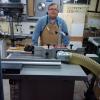I'm going to slap an amplifier cabinet together today. It will be made from 3/4" pine. I guess the nominal size is 1x8.
Anyway, I need to round the edges of the boards. I want something approaching a 1/4" radius. Vinyl will be applied over them.
I can do this quickly with the table router. Problem: small bows in the boards may cause the roundover bit to make irregular cuts, deeper in some places than others. One one side of a board, you can correct it by pushing the board down at the contact point. If the board is bowed up in the middle, that won't work as well.
I can put the boards in a vise and use a plane to round the corners, but I am not the most skilled person on earth, so again, I risk irregular cuts. I am not eager to use a handheld router because they are harder to control.
Best solution?





 Reply With Quote
Reply With Quote



 Please help support the Creek.
Please help support the Creek.



